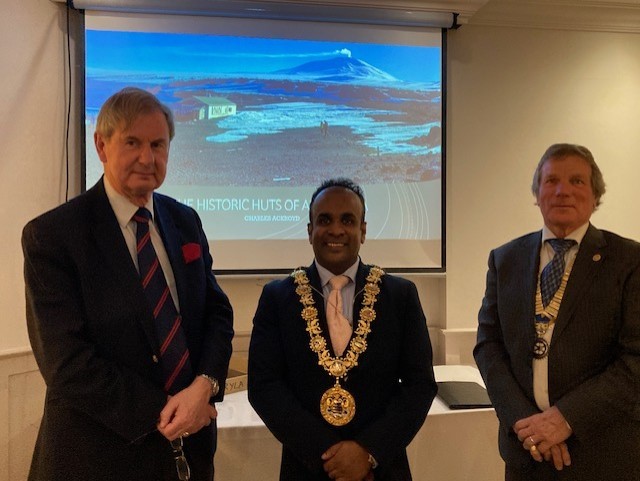Salisbury Rotarians See The Huts Of Antarctica
Members of Salisbury Rotary Club gave a warm welcome to The Right Worshipful the Mayor of the City of Salisbury, Councillor Mr Atiqul Hoque, and members of Wilton Rotary Club, to their Club evening. The guest speaker for the evening was Colonel Charles Ackroyd TD RD DL, Vice Lord-Lieutenant of Hampshire, who gave a fascinating talk on his trip to the Antarctic continent and, in particular, on some of the ‘The Historic Huts of Antarctica’.
Antarctica is the 5th largest continent, 40% larger than Europe and the focus of Colonel Ackroyd’s talk, which was wonderfully illustrated by slides, was on the huts, which were built for the south pole expeditions from 1899 onwards.

Colonel Charles Ackroyd, The Right Worshipful the Mayor of the City of Salisbury,
Mr Atiqul Hoque, and Michael Bell, President of Salisbury Rotary Club
Of the twenty two original sites, only seven huts remain intact, with the remainder in ruins or having disappeared completely. During his trip, Colonel Ackroyd visited four of these.
The huts were originally constructed as short-term structures designed to protect the continent’s explorers from the Antarctic weather, and to provide accommodation. While the buildings were only needed for 2-3 years at most, they had to be very strong and sturdily placed to withstand the relentless and fierce onslaught of the Antarctic winter elements. The New Zealand Heritage Trust is one of the forerunners in conserving and maintaining the seven remaining huts and some of the ruins.
This was a month long trip which started from the port of Invercargill near the southern tip of New Zealand’s south island. From there it was 10 days sailing across the Southern ocean via the Auckland and McQuarrie Islands to Cape Adare and the US base at McMurdo Sound.
The first hut at Cape Adare stems from 1899-1900 and was the base for the British Southern Cross Antarctic Expedition led by the Norwegian, Carson Borchengrevink, and was the first British venture of the Heroic Age of Antarctic Exploration, and the forerunner of the more celebrated journeys of Robert Falcon Scott and Ernest Shackleton. This was a fairly small hut but was used to overwinter the expeditioners.
Ross Island was discovered by Sir James Ross in 1841 and the hut on Ross Island was first used by Captain Robert Falcon Scott on the Discovery for his British National Antarctic Expedition from 1901-04 – although used primarily for storage.
Cape Royds Hut is also on Ross Island and was the base for the British Antarctic Nimrod Expedition led by Ernest Shackleton.
This expedition got within 97 miles of the South Pole and also featured the first ascent of the volcano on Ross Island, Mount Erabus. Gas lighting was used in the hut, where the outside temperature was as low as minus 42 degrees C.
The final Hut visited was Captain Scott’s Hut on Cape Evans, on the west side of Ross Island – the base for the British Antarctic Terranova Expedition and was the last led by Captain Robert Falcon Scott. This one got within 52 miles of the South Pole and was the largest with 25 men and 17 ponies, 7 mules and 23 dogs – all of the animals being housed in stables attached to the Hut.
There was so much that Captain Ackroyd covered and explained, with each of the huts containing many artefacts and the telling of the problems the expeditions had to overcome. Indeed, rescue missions were on occasion required for those who had been stranded including, for example, a group of six men (all of whom survived) who had to walk 200 miles from Hut Point to Inexpressible Island, a small, rocky island in Terra Nova Bay.
This was simply an evening not to be missed – full of history and a world so far removed from even a chilly Salisbury night.
News
- SALISBURY ROTARY YOUNG MUSICIANS WINNERS
Godolphin School was the venue for the Rotary Wessex District… - SALISBURY ROTARY CLUB WELCOMES A NEW MEMBER
President of the Rotary Club of Salisbury, Peter Mitchell, was… - SALISBURY ROTARY INSTALLS LIFE SAVING DEFIBRILLATOR
Salisbury Rotary Club was delighted to fund the installation of… - MAYOR OF SALISBURY VISITS ROTARY CLUB
At it latest Club evening, members of Salisbury Rotary Club… - HONEYPOT VISITS SALISBURY ROTARY
Salisbury Rotary Club welcomed its first guest speaker of the… - View all News
Events
- Salisbury Rotary Supporting The Clarendon Marathon in 2022
Full Marathon / Half Marathon / Relay (x4) /… - View all Events